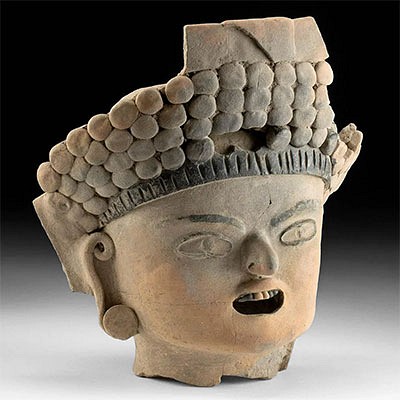Beautiful Ancient Greek Silver Fibula
Lot 20a
About Seller
Artemis Fine Arts
686 S Taylor Ave, Ste 106
Louisville, CO 80027
United States
Selling antiquities, ancient and ethnographic art online since 1993, Artemis Gallery specializes in Classical Antiquities (Egyptian, Greek, Roman, Near Eastern), Asian, Pre-Columbian, African / Tribal / Oceanographic art. Our extensive inventory includes pottery, stone, metal, wood, glass and textil...Read more
Categories
Estimate:
$500 - $750
Absentee vs Live bid
Two ways to bid:
- Leave a max absentee bid and the platform will bid on your behalf up to your maximum bid during the live auction.
- Bid live during the auction and your bids will be submitted real-time to the auctioneer.
Bid Increments
| Price | Bid Increment |
|---|---|
| $0 | $25 |
| $300 | $50 |
| $1,000 | $100 |
| $2,000 | $250 |
| $5,000 | $500 |
| $10,000 | $1,000 |
| $20,000 | $2,500 |
| $50,000 | $5,000 |
| $100,000 | $10,000 |
| $200,000 | $20,000 |
About Auction
By Artemis Fine Arts
May 18, 2023
Set Reminder
2023-05-18 10:00:00
2023-05-18 10:00:00
America/New_York
Bidsquare
Bidsquare : Ancient | Asian | Ethnographic Art
https://www.bidsquare.com/auctions/artemis-gallery/ancient-asian-ethnographic-art-12797
Featuring classical antiquities, ancient, and ethnographic art from cultures encompassing the globe. Egyptian, Greek, Roman, Near Eastern, Asian, Pre-Columbian, Native American, African / Tribal, Oceanic, Spanish Colonial, Fossils, more! All legally acquired, legal to sell. Satisfaction guaranteed. Artemis Fine Arts info@artemisfinearts.com
Featuring classical antiquities, ancient, and ethnographic art from cultures encompassing the globe. Egyptian, Greek, Roman, Near Eastern, Asian, Pre-Columbian, Native American, African / Tribal, Oceanic, Spanish Colonial, Fossils, more! All legally acquired, legal to sell. Satisfaction guaranteed. Artemis Fine Arts info@artemisfinearts.com
- Lot Description
Greece, especially northern Greece, Classical period, ca. 5th to 4th century BCE. A beautiful silver fibula (brooch) of arched form, with 5 large, studded bands around its curved, half-moon shape. A palmette forms one end of the clasp, while an abstract anthropomorphic form with two "eyes" that look like they may have once had copper inlays forms the other end. This side has a folded over piece of silver on the back that the pin would have slotted into to hold it in place. Fibulae were brooches used to fasten or pin garments such as cloaks by various ancient cultures. In addition to being functional - taking the place of straight pins used during the Neolithic and Bronze Age - these accessories were quite decorative. Although buttons would eventually replace them, the safety pins that we use today may be understood as descendants of these forms. A fibula cast from silver is quite rare. Size: 1.7" W x 1" H (4.3 cm x 2.5 cm); silver quality: 63.2%; weight: 10.2 grams
Cf. Metropolitan Museum of Art, 52.36.
Provenance: East Coast collection, New York Gallery, New York City, New York, USA, acquired before 2010
All items legal to buy/sell under U.S. Statute covering cultural patrimony Code 2600, CHAPTER 14, and are guaranteed to be as described or your money back.
A Certificate of Authenticity will accompany all winning bids.
We ship worldwide and handle all shipping in-house for your convenience.
#175440Missing pin which inhibits wearability. Some nicks and abrasions to surface, all commensurate with age, but otherwise excellent with nice remaining detail and rich patina.Condition
- Shipping Info
-
All shipping is handled in-house for your convenience. Your invoice from Artemis Gallery will include shipping calculation instructions. If in doubt, please inquire BEFORE bidding for estimated shipping costs for individual items.
-
- Buyer's Premium



 EUR
EUR CAD
CAD AUD
AUD GBP
GBP MXN
MXN HKD
HKD CNY
CNY MYR
MYR SEK
SEK SGD
SGD CHF
CHF THB
THB












